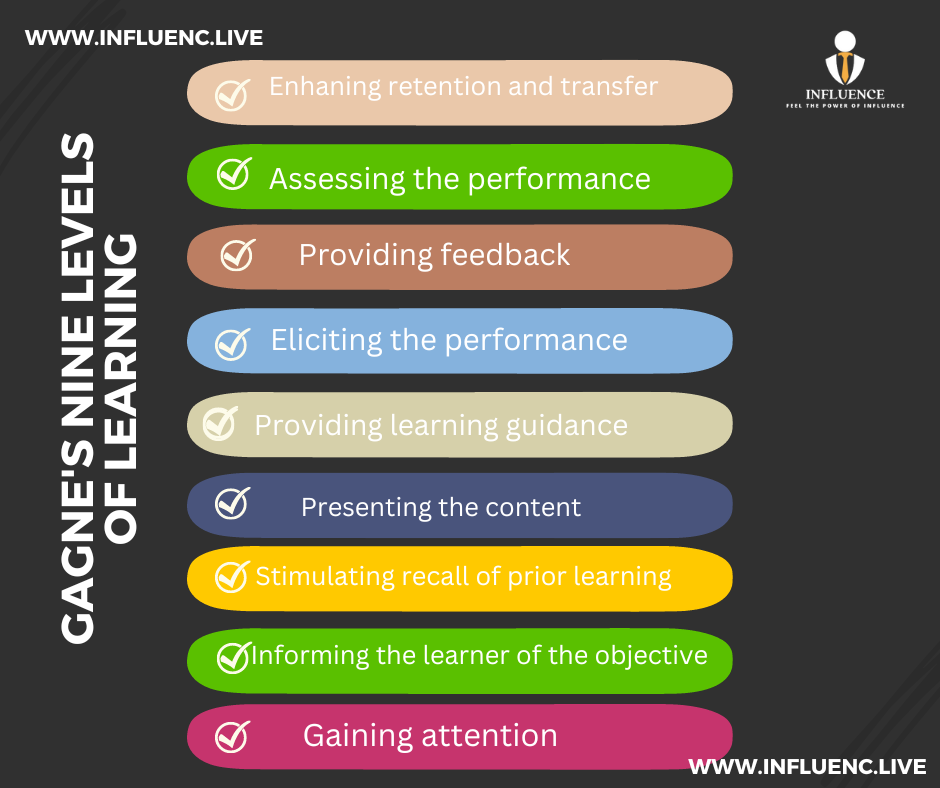Instructional Design Theories
Instructional design refers to the process used to create instructional material.
It is used to identify gaps in knowledge, skills, and attitudes of students or employees, analyzing
learning needs and developing learning material to meet those needs.
Instructional design helps give meaningful and effective instructions to learners in a way that will
make learning easier for them.
It is used to identify gaps in knowledge, skills, and attitudes of students or employees, analyzing
learning needs and developing learning material to meet those needs.
Instructional design helps give meaningful and effective instructions to learners in a way that will
make learning easier for them.
Types of Instructional Theories
-
ADDIE model
-
Gagne’s Nine Events of Instruction
-
Ropes
-
Merrill’s Principles of Instruction.
-
The Kemp Instructional Design model.
-
ASSURE Model
In this article we will she more light on this effective model ( Gagne’s Nine Levels of Learning).
Robert M. Gagné (1916–2002) was an educational psychologist who pioneered the science of instruction
in the 1940s. His book “The Conditions of Learning,” first published in 1965, identified the mental
conditions that are necessary for effective learning.
Gagne’s Nine Levels of Learning
-
Grabbing attention
-
Informing the learner of the objective
-
Stimulating recall of prior learning
-
Presenting the content
-
Providing learning guidance
-
Eliciting the performance
-
Providing feedback
-
Assessing the performance
-
Enhancing retention and transfer
Instruction and Practice
Gaining Attention (Reception)
Start the learning experience by gaining the attention of your audience. This change in stimulus alerts
the group that learning will soon take place.
Apply: Gain attention by raising the volume of your voice, gesturing, telling a story, sharing shocking
fact, showing a short video on the topic of instruction, or using any other event that brings the period
of “waiting for the lesson to start” to an end.
Next, you must ensure that your team knows what they need to learn, and that they understand why
they’re about to learn this new information.
Apply: Explain to your team what they will have learnt by the end of the session. Then, explain how
their learning is going to benefit them, and the organization.
-
Providing measurable criteria they must meet at the end of the lesson.
-
Explaining a task they’ll be asked to perform.
-
Drawing a clear connection between prior-stated objectives and later assessments.
-
Involving the students by asking for their input in determining ways to test knowledge and understanding
Stimulating Recall of Prior Learning (Retrieval)
When your people learn something new, match the new information with related information or topics they’ve learned in the past.
Apply: Review any previous learning that you’ve done with your team, and apply it to what they’re
learning now.
Also, ask your team if they have any previous experiences with the topic, or if they have experienced
the problems that the training is trying to resolve. Then make connections between what they are
learning, and their previous learning.
Doing a quick summary or review of past lessons.
Prompting students to answer questions about things they learned before related to the subject.
Asking the students to explain what they recall.
Using engaging audiovisual presentations of material.

Presenting the Stimulus (Selective Perception)
Present the new information to the group in an effective manner.
Apply: Organize your information in a logical and easy-to-understand manner.
Try to use a variety of different media and styles (such as visual cues, verbal instruction, and active
learning) to suit people with different learning styles.
This presentation stage should be carefully planned out, but with enough flexibility to allow for
spontaneous discourse.
Providing Learning Guidance (Semantic Encoding)
When your people learn something new, match the new information with related information or topics
they’ve learned in the past.
Apply: Review any previous learning that you’ve done with your team, and apply it to what they’re
learning now. Also, ask your team if they have any previous experiences with the topic, or if they have
experienced the problems that the training is trying to resolve.
Then make connections between what they are learning, and their previous learning.
The point here is to help the information be understood in the present and stored deep enough so as
not to be forgotten the moment they walk out the door.
If you ask them to write an essay, it’s handy to offer them a sample of what a perfect essay would look
like for the purpose of the lesson.
Giving an example of what not to do is an excellent way to offer contrast, so they can avoid making
mistakes.
Other aspects of this step include providing:
-
Graph
-
Stories
-
Role-playing
-
Mnemonic memory tricks
-
Or any stimuli that facilitate memory by attributing value to the lesson concepts are all potentially useful.
Eliciting Performance (Responding)
At this stage, you need to ensure that your people can demonstrate their knowledge of what you’ve
taught them. The way that they show this depends on what they’re learning.
Apply: Now it’s time for the students to do their part i.e., giving them the chance to show you that they
did their job and learned what you taught.
If you’ve taught a new process or skill, ask your people to demonstrate how to use it (role playing
exercises can be useful for this).
It’s a critical step because it allows educators to gauge their success and lets the student practice and
thereby reinforce knowledge.
They must either practice or demonstrate their newfound knowledge in a manner you can assess. This
is known as eliciting the performance
Repetition always helps with memorization as well as confidence-building.
A few ways to elicit performance include tests, quizzes, classroom presentations, essays, group
projects, and application-oriented lab exercises.
Providing Feedback (Reinforcement)
After your team demonstrates their knowledge, provide feedback and reinforce any points as
necessary.
Apply: Imagine that you’ve taught your team a new technique for handling difficult customers. After
several role playing scenarios, you notice that a few team members aren’t assertive enough to calm
the customer in this fictional “tense situation.” Your feedback and tips point out their mistakes so that
they can correct them.
Descriptive or analytic feedback is explicitly designed to boost student performance by offering
additional assistance, including tips or exact action steps to take.
Peer-evaluation helps students recognize differences between their work and that of peers to close the gap.
Self-evaluation teaches ways students can spot areas for improvement on their own.
Assessing Performance (Retrieval)
Your team should be able to complete a test, or other measurement tool, to show that they’ve learned
the material or skill effectively. Team members should complete this test independently, without any
help or coaching from you.
Apply: Tests, short questionnaires, or even essays can be good ways of testing your team’s new
knowledge.
Keep in mind one performance cannot provide enough data to measure overall knowledge and
abilities. Still, it will give enough insights to measure how well they learned and stored the information
provided during a particular lesson.
Assessment techniques include giving oral quizzes or offering pre- and post-lesson quizzes to measure
learning efficacy.
No matter which methods are used, they should be objective, logical, and based on pre-established
criteria outlined in rubrics when practical.
Enhancing Retention and Transfer (Generalization)
It is time to build retention and transfer. In this last stage, your team members show that they’ve
retained information by transferring their new knowledge or skill to situations that are different from
the ones you’ve trained them on.
Apply: Repeated practice is the best way to ensure that people retain information and use it
effectively. Make sure that your team has enough opportunity to use their learning on a regular basis.
Schedule “practice runs” if you’ve been training on a new process, or have a follow-up session to review
information or skills.
Retention implies the student’s ability to internalize then remember what they learned.
Transfer describes their capacity to apply the knowledge and skills in the real world. Both are readily
enhanced through an abundance of practice.
Such practice should be creative and not merely rote repetition, which tends to bore learners.
Another potential problem educators can run into with this step is time itself, so a few practical tips:
-
For enhancement, adding questions about previously-taught content is useful.
-
Giving creative assignments that require students to think about the lesson in dynamic new
-
Ways being transparent about goals and learning outcomes, so students can see exactly what
-
they’re supposed to learn for each lesson as well as by the end of all lessons.
Gagne’s Nine Levels of Learning is an effective instructional design theory which adds more value and
provide the learners with a unique learning experience.



